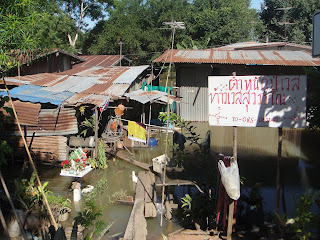 |
To start building an Ovitrap, you have to remove the top off of
1.5 L pop bottles and spray paint them black |
 |
You wrap a piece of black cloth around a piece of bamboo
and attach it with thumbtacks (not an easy task). Then, you roll the cloth over the top of the bambo (as seen above) and use a bow saw to cut the bamboo so it is only about 1.5 inches thick |
These pictures both show the inside of the Ovitrap. A nylon screen has been attached to the bamboo and the cloth is attached to the outside of the pop bottles.
An ovitrap works by filling the bottle with water to right under the screen. Because the cloth goes down into the bottle, it will become damp and the entire cloth will get wet as the water seeps up the sides of the cloth. Mosquitoes will be attracted to the device, because it will be placed in a dark area and they like to lay their eggs on dark, damp surfaces. They will lay their eggs on the cloth. When the eggs hatch, the larva will drop through the the screen into the water. When the larva matures, the mosquitoes will be too large to fit back up through the screen and will die.
 |
| My first picture of flooding. The flooding is now higher than the blue and white striped roof. I went boating through this area last week. |
 |
| All of these homes are on stilts or are floating homes. The water path between the homes used to be a road |
 |
| You can see the reflection of water inside the home. Although they have a makeshift path to get them to the street, they cannot avoid the water in their own home |

















Impressive device.
ReplyDeleteSawa dee!
ReplyDeleteYou are the first to explain how to build an ovitrap.
But could you be more specific on the nylon screen? More pics please? Could you make a more precise step by step photo with materials on how to build the ovitrap?
Thanks!
Chock Dee!